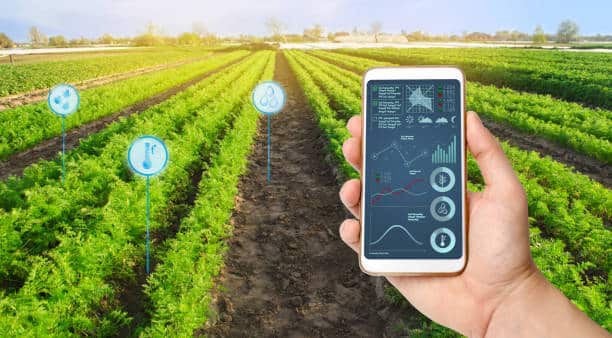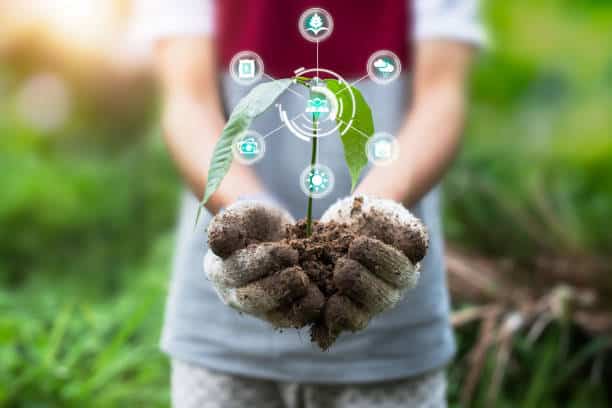IoT in Agriculture The agricultural sector has witnessed transformative changes over the past few decades, driven by technological advancements.
One of the most significant innovations in this field is the Internet of Things (IoT).
IoT in agriculture, also known as smart farming, involves the use of interconnected devices to collect, analyze, and act upon data in real time.
This article explores the various aspects of IoT in agriculture, detailing its benefits, applications, and the future it promises for smarter growth.
1. Introduction to IoT in Agriculture

The Internet of Things (IoT) refers to a network of physical objects embedded with sensors, software, and other technologies to connect and exchange data with other devices and systems over the Internet.
In agriculture, IoT applications range from soil sensors and weather stations to autonomous vehicles and drones. These interconnected devices provide farmers with real-time data, enabling them to make informed decisions and optimize their operations.
The integration of IoT in agriculture aims to increase productivity, reduce waste, and ensure sustainable farming practices.
2. Benefits of IoT in Agriculture
IoT offers numerous benefits to the agricultural sector. One of the primary advantages is enhanced efficiency.
By providing precise data on various factors such as soil moisture, temperature, and crop health, IoT devices enable farmers to optimize resource use.
This leads to better water management, efficient use of fertilizers, and reduced energy consumption. Additionally, IoT enhances crop monitoring and disease management.
With real-time data, farmers can detect pest infestations and diseases early, allowing for timely interventions that minimize crop losses and reduce the need for chemical treatments.
Another significant benefit is the potential for cost savings. IoT devices can automate various farming processes, reducing the need for manual labor and lowering operational costs.
Furthermore, the data collected can be used to predict crop yields and market conditions, helping farmers make strategic decisions about planting and harvesting times. This predictive capability not only improves profitability but also reduces waste by aligning production with demand.
3. Precision Agriculture: A Revolution in Farming
Precision agriculture, enabled by IoT, is revolutionizing farming practices. This approach involves using IoT devices to gather detailed data about field conditions and precisely apply inputs, such as water, fertilizers, and pesticides.
For instance, soil sensors can provide information on soil nutrient levels, moisture content, and pH, allowing farmers to tailor their fertilizer applications to specific areas of the field.
This targeted approach not only enhances crop yields but also minimizes the environmental impact by reducing the runoff of chemicals into water bodies.
Drones and satellite imagery are other essential components of precision agriculture. Equipped with advanced sensors, drones can capture high-resolution images of fields, identifying areas that require attention.
These images can reveal patterns of crop growth, detect anomalies, and even estimate crop health. By combining this data with other IoT inputs, farmers can develop comprehensive management plans that maximize productivity and sustainability.
4. IoT-Driven Irrigation Systems
Water management is a critical aspect of agriculture, especially in drought-prone regions. IoT-driven irrigation systems offer a solution by optimizing water use based on real-time data.
These systems use soil moisture sensors, weather forecasts, and crop water requirements to determine the exact amount of water needed for each section of a field. Automated irrigation systems can then deliver precise amounts of water, reducing waste and ensuring that crops receive adequate hydration.
Smart irrigation systems not only conserve water but also enhance crop quality. By maintaining optimal soil moisture levels, these systems prevent overwatering and underwatering, both of which can stress plants and reduce yields.
Moreover, the integration of IoT in irrigation can lead to significant cost savings by reducing water bills and energy costs associated with pumping and distributing water.
5. Enhancing Livestock Management with IoT

Livestock farming also benefits from IoT technology. Wearable devices, such as collars and ear tags equipped with sensors, can monitor the health and activity of animals.
These devices provide data on vital signs, movement patterns, and feeding behavior, enabling farmers to detect health issues early and take preventive measures. For example, a sudden change in an animal’s activity level could indicate illness, prompting a veterinarian’s intervention before the condition worsens.
IoT devices can also improve breeding programs by monitoring reproductive cycles and identifying the optimal time for insemination.
This enhances the efficiency of breeding operations and increases the chances of successful pregnancies. Additionally, automated feeding systems can ensure that livestock receive the right amount of feed at the right times, promoting healthy growth and reducing feed waste.
6. Automated Machinery and Robotics
Automation is becoming increasingly prevalent in agriculture, with IoT playing a crucial role in this trend.
Autonomous tractors, harvesters, and planting machines are now equipped with IoT sensors and GPS technology, allowing them to perform tasks with minimal human intervention. These machines can operate around the clock, increasing productivity and reducing labor costs.
Robotics, combined with IoT, is also making strides in crop harvesting. Robots equipped with cameras and sensors can identify ripe fruits and vegetables, picking them with precision and care.
This reduces the damage to produce and ensures that only the highest quality items are harvested. Additionally, automated machinery can handle tasks such as weeding and soil preparation, further streamlining farming operations and improving efficiency.
7. Predictive Analytics and Data Management
The vast amount of data generated by IoT devices in agriculture can be overwhelming, but it also presents opportunities for advanced data analytics.
Predictive analytics involves analyzing historical and real-time data to forecast future events and trends. In agriculture, this can mean predicting crop yields, identifying pest outbreaks, and anticipating weather conditions.
Farm management software integrates data from various IoT devices, providing farmers with a comprehensive view of their operations.
These platforms use machine learning algorithms to analyze data and offer actionable insights. For instance, they can recommend the best times for planting and harvesting based on weather patterns and soil conditions.
By leveraging predictive analytics, farmers can make data-driven decisions that enhance productivity and sustainability.
8. Challenges and Barriers to IoT Adoption
Despite its many benefits, the adoption of IoT in agriculture faces several challenges. One significant barrier is the high cost of IoT devices and infrastructure.
Many small-scale farmers may find it difficult to afford the initial investment required to implement IoT solutions. Additionally, there are concerns about data privacy and security.
The vast amount of data generated by IoT devices can be vulnerable to cyberattacks, and farmers may be wary of sharing sensitive information.
Another challenge is the lack of technical expertise among farmers. Implementing and maintaining IoT systems requires specialized knowledge, which may not be readily available in rural areas.
Moreover, connectivity issues can hinder the effectiveness of IoT devices, especially in remote regions with limited internet access. Addressing these challenges will be crucial for the widespread adoption of IoT in agriculture.
9. Case Studies: IoT in Action

Several case studies highlight the successful implementation of IoT in agriculture. One example is a vineyard in California that uses soil moisture sensors and weather stations to optimize irrigation. By applying water only when necessary, the vineyard has reduced its water usage by 25% while maintaining high grape quality.
Another case study involves a dairy farm in the Netherlands that uses wearable sensors to monitor cow health and activity. The data collected has enabled the farm to detect illnesses early, improving animal welfare and reducing veterinary costs. Additionally, the farm has implemented automated feeding systems that have led to more efficient feed use and better milk production.
10. The Future of IoT in Agriculture
The future of IoT in agriculture looks promising, with continuous advancements in technology and increasing adoption among farmers.
Emerging technologies such as 5G networks and edge computing are expected to enhance the capabilities of IoT devices, providing faster data processing and improved connectivity. This will enable even more precise and efficient farming practices.
Furthermore, the integration of artificial intelligence (AI) with IoT will open new possibilities for smart farming. AI algorithms can analyze complex data sets, offering deeper insights and automating decision-making processes.
For example, AI-powered drones could autonomously monitor crop health and apply treatments as needed, further reducing labor costs and improving productivity.
As the global population continues to grow, the demand for food will increase, placing additional pressure on agricultural systems.
IoT offers a solution by enabling more sustainable and efficient farming practices. By embracing IoT technology, the agricultural sector can meet the challenges of the future and ensure food security for generations to come.
Conclusion
IoT in agriculture is transforming the way we grow and manage crops and livestock. By providing real-time data and automating various processes, IoT technology enhances efficiency, reduces costs, and promotes sustainable farming practices.
While there are challenges to overcome, the benefits of IoT in agriculture are undeniable. As technology continues to evolve, IoT will play an increasingly vital role in ensuring smarter growth and a more sustainable future for agriculture.

